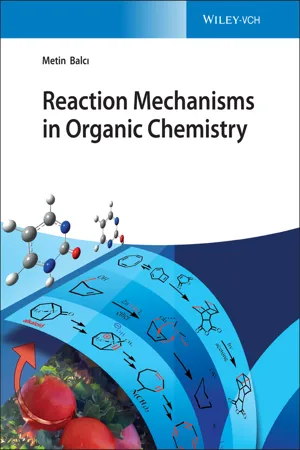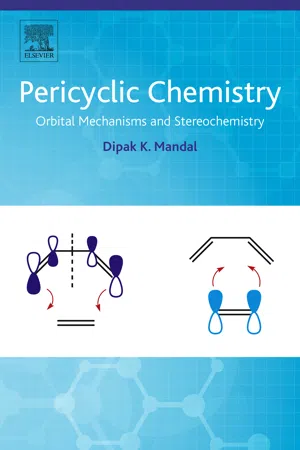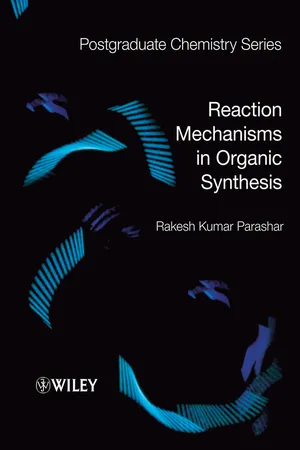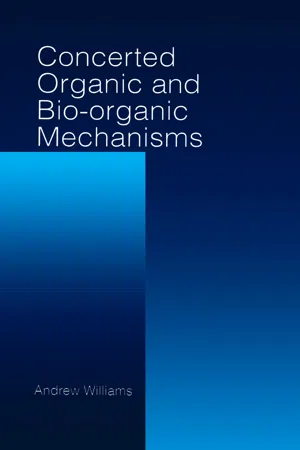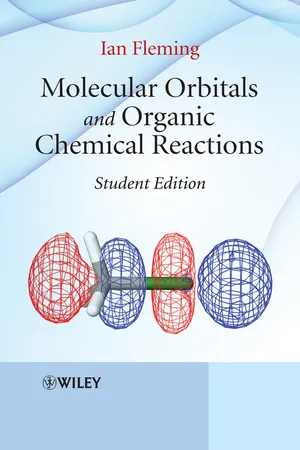Chemistry
Electrocyclic Reactions
Electrocyclic reactions are a type of pericyclic reaction in which a cyclic compound undergoes ring-opening or ring-closing reactions upon exposure to heat or light. These reactions involve the breaking and formation of sigma bonds and are governed by the Woodward-Hoffmann rules. Electrocyclic reactions have important applications in organic synthesis and materials science.
Written by Perlego with AI-assistance
Related key terms
Related key terms
1 of 4
Related key terms
1 of 3
6 Key excerpts on "Electrocyclic Reactions"
- eBook - ePub
- Metin Balc?, Metin Balc?, Metin Balc?, Metin Balc?, Metin Balc?(Authors)
- 2021(Publication Date)
- Wiley-VCH(Publisher)
10 Pericyclic ReactionsIn organic chemistry, reactions can be classified according to their mechanisms into three groups.- Ionic or polar reactions
- Radical reactions
- Pericyclic reactions
Ions and radicals occur as intermediates in polar and radical reactions. Solvent polarity significantly affects the reaction. Pericyclic reactions have characteristic features compared to polar and radical reactions.- The reactions proceed in a concerted manner and bond cleavage and bond forming occur simultaneously in a single step.
- Generally, a cyclic transition complex is formed.
- No intermediates are formed in pericyclic reactions.
- Heat or light is required to start the reactions.
- Reactions are stereoselective.
- Solvent polarity generally does not affect the reaction rate or product distribution.
Electrocyclic Reactions: An electrocyclic reaction is a unimolecular process in which a new σ bond across the end of a conjugated π system is formed. During this process, the double bonds are displaced and a cyclic compound is formed containing one more σ bond and one fewer π bond than the reactant. The conversion of 1,3,5-hexatriene to 1,3-cyclohexadiene is one of the most typical examples of these reactions.The reverse or retroelectrocyclic reaction can also occur. In the reverse reaction, a σ bond of a cyclic compound breaks to form a conjugated product with one more π bond, such as the conversion of 1,3-cyclohexadiene to 1,3,5-hexatriene. An additional example is the opening of a cyclobutene ring by heat or photochemical reaction. As the σ bond in the ring opens, a new double bond is formed.Cycloaddition reactions - eBook - ePub
Pericyclic Chemistry
Orbital Mechanisms and Stereochemistry
- Dipak Kumar Mandal(Author)
- 2018(Publication Date)
- Elsevier(Publisher)
Fig. 3.9B , both examples indicate a [2 + 2] cycloaddition. However, the cycloaddition of two alkenes is a (2 + 2) cycloaddition giving a four-membered ring, and carbene cycloaddition is a (2 + 1) cycloaddition forming a cyclopropane ring. Cycloaddition reactions are most versatile and numerous among the four pericyclic classes.3.2.2 Electrocyclic Reactions
An electrocyclic reaction denotes a ring closing process in which a new σ bond is formed between the ends of a conjugated π system to give a cyclic system with shorter conjugation, or the reverse ring opening process when a σ bond of a cyclic system is broken to give a longer conjugated π system. Both electrocyclic ring closing (cyclization) and ring opening reactions are unimolecular and are characterized by Δσ = ± 1 (Fig. 3.10 ). As shown, the ring closing of hexatriene leads to a reduction of one π bond to form cyclohexadiene while the ring opening of cyclobutene causes an increase of one π bond to give butadiene. Electrocyclic Reactions are reversible, and involve the transformation of one π bond into one σ bond, or the reverse.Fig. 3.10 Characteristics of Electrocyclic Reactions.3.2.3 Sigmatropic Rearrangements
A sigmatropic rearrangement indicates the migration of a σ bond (adjacent to one or two π components) from one position to another in a molecule with concomitant reorganization of the π system(s). In this process, an old σ bond is broken and a new σ bond is formed. The reaction is therefore inherently reversible; the direction in which the rearrangement is favoured is determined by thermodynamics. A sigmatropic rearrangement is evidently unimolecular, and is characterized by Δσ = 0 (Fig. 3.11 ). Note that one end of the migrating σ bond is next or adjacent to a p orbital of the π component.Fig. 3.11 Characteristics of a sigmatropic rearrangement.A sigmatropic rearrangement is designated by its order [i ,j ] where i and j are positive integers. The order is subclassified into two types: [1,j ] (j > 1) when one π component is involved, and [i ,j ] (i - eBook - ePub
- Rakesh Kumar Parashar(Author)
- 2013(Publication Date)
- Wiley-Blackwell(Publisher)
Chapter 8
Pericyclic Reactions
Pericyclic reactions are a class of reactions that include some of the most powerful synthetically useful reactions such as the Diels–Alder reaction. Pericyclic reactions often proceed with simultaneous reorganization of bonding electron pairs and involve a cyclic delocalized transition state. They differ from ionic or free radical reactions as there are no ionic or free radical intermediates formed during the course of the reaction. They proceed by one-step concerted mechanisms and have certain characteristic properties (although there are some exceptions to all these rules).1. Pericyclic reactions often proceed with a high degree of stereospecificity.2. Although some pericyclic reactions occur spontaneously, most reactions can be frequently promoted by light as well as heat. Normally, the stereochemistry under the two sets of conditions is different. Thus, there may be two main reaction conditions, thermal (in ground state) and photochemical (in excited state).3. Pericyclic reactions are relatively unaffected by solvent changes and can occur in the gas phase with no solvent. Normally, they are unaffected by the presence of electrophilic and nucleophilic catalysts.4. Normally, no catalyst is needed to promote the reactions. But Lewis acids may catalyze many forms of pericyclic reactions, either directly or by changing the mechanism of the reaction so that it becomes a stepwise process and hence no longer a true pericyclic reaction.8.1 Important classes of pericyclic reactions
There are four major classes of pericyclic reactions: cycloaddition, electrocyclic, sigmatropic and ene reactions. All these reactions are potentially reversible. A general illustration of each class is given below.8.1.1 Cycloaddition reactions
A cycloaddition reaction involves the concerted formation of two σ-bonds between the termini of two π-systems. The reverse reaction involves the concerted cleavage of two σ-bonds to produce two π-systems. The simplest example being the hypothetical combination of two ethene molecules to give cyclobutane. This does not occur under normal heating, but the cycloaddition of 1,3-butadiene to ethene does, and this is an example of the Diels–Alder reaction - eBook - ePub
Electron Flow in Organic Chemistry
A Decision-Based Guide to Organic Mechanisms
- Paul H. Scudder(Author)
- 2023(Publication Date)
- Wiley(Publisher)
Sigma molecular orbitals pose a difficult representational problem, for they usually are as large and as complex as the framework of the molecule itself. Commonly we treat the sigma framework as if it were completely localized, chopping up the representational problem into intellectually convenient little pieces, each piece corresponding to a particular bond or electron pair. Toward this end, the atomic orbitals are mixed to give hybridized orbitals that are more convenient for the discussion of these localized bonding orbitals. These localized bonding orbitals are easy to use and correspond to the lines and dots of our Lewis formula. There are very few penalties for using hybrid orbitals and treating the sigma framework as localized, when it actually is not.13.7 CONCERTED PERICYCLIC CYCLOADDITION REACTIONS
13.7.1 Introduction to Pericyclic Reactions
Pericyclic reactions have cyclic transition states and electron flow paths that appear to go around in a loop. There are three main types of pericyclic reactions shown in Figure 13.37 : cycloaddition reactions, Electrocyclic Reactions, and sigmatropic rearrangements. Cycloaddition reactions form a ring from two pi systems coming together. Electrocyclic Reactions close the ends of a single pi system to form a ring or the reverse, open a ring to form a single pi system. Sigmatropic rearrangements move a sigma bond from one part of a pi system to another. The examples shown all have a transition state in which six electrons move around in a loop. The rules for prediction of the products will depend on many factors, including the number of electrons in the process.Examples of the three types of pericyclic reactions.Figure 13.3713.7.2 Cycloaddition Reactions
Four‐Electron (4n) Cycloaddition Reactions
Concerted four electron suprafacial–suprafacial cycloaddition reactions are not “thermally allowed.” All this really means is that the transition state for an allowed process is much lower in energy. Suprafacial just means on the same side or face of the molecule; antarafacial means on opposite faces. HOMO–LUMO theory explains why the concerted 2 + 2 cycloaddition of two ethylenes is not favored. Bonding overlap between a HOMO and a LUMO lowers the transition state energy of the allowed process, making it favorable. Figure 13.38 - eBook - ePub
- Andrew Williams(Author)
- 2020(Publication Date)
- CRC Press(Publisher)
Chapter 7Cyclic Reactions
Cyclic reactions such as the Diels-Alder cycloaddition, the Cope and the Claisen rearrangements have substantial synthetic1 and biological2 significance (Scheme 7.1). The biosynthesis of lanosterol derivatives and associated biomimetic cyclisations, many fragmentation reactions such as decarboxylation, and extrusion of nitrogen and sulphur dioxide constitute part of this large class of reactions. Prior to the mid-1960’s evidence had been accumulating which suggested that some cyclic reactions do not possess intermediates and for this reason they were termed “no mechanism” reactions. The available evidence suffered from a lack of precision when judged against current standards and is summarised in review articles by Sara Jane Rhoads.3 ,4Scheme 7.1 Some cyclic reactions.The orbital-symmetry theories of Hoffmann and Woodward5 do not require that pericyclic reactions should be concerted6 but their formulation encouraged renewed efforts in the diagnosis of concerted mechanisms in such systems. The eponymous selection rules5 originated from strong qualitative arguments based on symmetry and explain the stereochemical course of thermal cyclic reactions. Qualitative and quantitative molecular orbital theory has figured extensively in discussions of transition state structure in cyclic reactions and the original idea of concertedness appears to have arisen because of the high degree of stereospecificity invariably observed in these systems. Stereospecificity is required by, but does not require, concertedness; while it is not a precise mechanistic tool, it can be employed in the diagnosis of concerted mechanisms in certain circumstances.7.1 INTERMEDIATES
7.1.1 Direct observation
The hydrogen-iodine thermal combination reaction obeys a second-order rate-law (rate = k2 [H2 ][I2 ])7 which is consistent with a bimolecular mechanism involving a four-centred transition structure (Scheme 7.2). For many years the mechanism was believed to be concerted (four-centre) until consideration of the Hoffmann and Woodward theories indicated the problem that it is not allowed by the symmetry rules.8 Photochemical initiation allows the reaction to occur at a lower temperature than that of the thermal reaction but the Arrhenius parameters for both photochemical and thermal reactions are identical.9 ,10 ,11These results are consistent with a radical chain mechanism which can be initiated either thermally or photochemically but they do not fit the simple bimolecular mechanism. The observation of radical or di-radical species in a cyclic reaction may be effected by a number of techniques, few of which were available in the early 1960’s.12 ,13 - Ian Fleming(Author)
- 2011(Publication Date)
- Wiley(Publisher)
6.7 , and no reaction should be described in this way in the absence of a drawing like these.Fig. 6.7 The Diels-Alder reaction as a [π 2s + π 2s +π 2s ] and as a [π 2s + π 2a +π 2a ] reactionIt is easy enough to see how to extend the labelling of cycloaddition reactions to those involving larger conjugated systems. As just one example, the cycloaddition of heptafulvalene to tetracyanoethylene has overlap developing on opposite sides of the 14-electron component, which is therefore a (4q + 2)a component, and does not count towards the sum. The overlap on the 2-electron component, although not proved, is probably suprafacial, and, as a (4q + 2)s component, does count.6.3.2.2 Electrocyclic Reactions.For Electrocyclic Reactions, we need to see how the words suprafacial and antarafacial are defined for σ bonds, for which we use orbitals made from overlapping spn hybrids. Just as a suprafacial event on a π bond has overlap developing to the two overlapping lobes that contribute to bonding, so with σ bonds, overlap that develops to the two large lobes of the spn hybrids is suprafacial. Less obviously, overlap that develops to the two small lobes is also suprafacial, because it is the counterpart to overlap developing to the other two lobes in a π bond. Antarafacial overlap is when one bond is forming to an inside lobe and one to an outside lobe, either way round.The electrocyclic interconversion of the cyclobutene 6.47 and the cis, trans -butadiene dicarboxylic ester 6.48 is shown in Fig. 6.8a . The components for the ring opening are the σ bond made from two sp3 hybrids drawn in front and the π bond drawn at the back, and the conrotatory ring opening is shown as a [π 2a + π 2s ] process. In the ring-closing direction there is only one component, the π system of the diene, and the conrotatory ring closing is shown as a [π 4a
Index pages curate the most relevant extracts from our library of academic textbooks. They’ve been created using an in-house natural language model (NLM), each adding context and meaning to key research topics.
Explore more topic indexes
Explore more topic indexes
1 of 6
Explore more topic indexes
1 of 4
